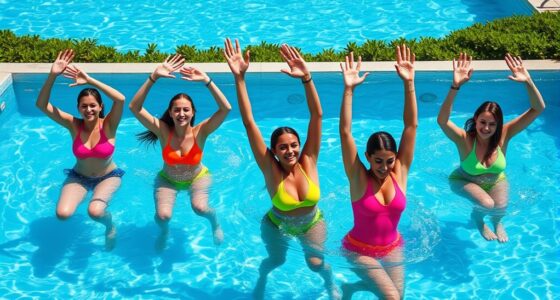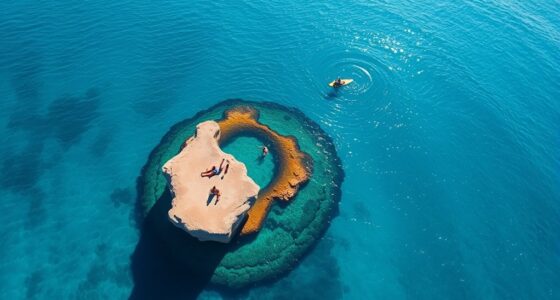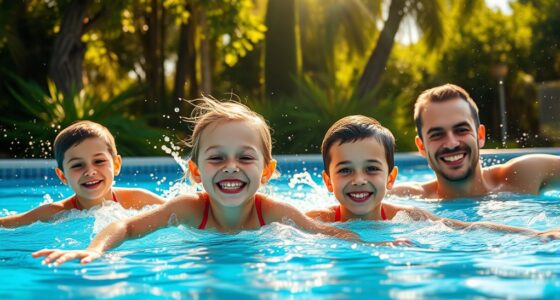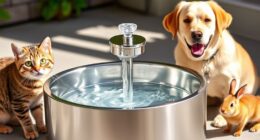To ensure your toddler stays warm in the pool, put them in thermal swimwear and choose indoor or heated pools. Encourage movement to generate body heat and consider a thermal rash vest for added warmth. After swimming, wrap them in a hooded towel and dress them in woolen thermal clothing. Keep the water temperature around 30°C for comfort and safety. Use neoprene wetsuits for insulation. Swim caps can help retain body heat. Gently pat dry with a microfiber towel after swimming. These tips will help ensure your toddler’s comfort and safety in the pool.
Key Takeaways
- Dress toddlers in thermal swimwear for insulation and warmth.
- Maintain optimal water temperature around 30°C for comfort.
- Use hooded towels and warm clothing post-swim for coziness.
- Consider neoprene wet suits for added insulation and safety.
- Encourage movement to generate body heat before entering the pool.
Importance of Warmth in Pool
Staying warm in the pool is vital for your toddler's enjoyment and comfort during swim time. The right temperature in the pool plays a significant role in ensuring that your little one has a positive swimming experience.
When the water is adequately warm, your toddler is more likely to stay engaged, focused, and happy during swimming lessons. Cold water can lead to discomfort, making your child feel chilly and uninterested in swimming activities.
By maintaining warmth in the pool, you create a conducive environment for your toddler to learn and have fun in the water. This is essential for fostering a love for swimming at an early age and ensuring that your child associates the pool with enjoyable experiences.
Providing the right level of warmth in the pool is key to supporting your toddler's comfort, engagement, and overall satisfaction during swimming sessions.
Choosing Thermal Swimwear
For ideal warmth and comfort in the pool, consider selecting thermal swimwear for your toddler. Thermal swimwear, like Konfidence's Babywarma suit made of 2mm neoprene, is designed to regulate your toddler's body temperature while swimming. By layering with thermal swimwear, your toddler can stay warm and comfortable, especially in pools with cooler water temperatures. Konfidence offers a variety of warming swimwear options for toddlers, including swimsuits and pool wetsuits, all aimed at enhancing comfort and warmth during swimming sessions.
To help you choose the right thermal swimwear for your toddler, take a look at the comparison table below:
| Thermal Swimwear Brand | Material | Features | Price |
|---|---|---|---|
| Konfidence Babywarma | 2mm neoprene | Regulates body temperature | $30 |
| Konfidence Warming Swimsuit | Neoprene blend | Comfortable fit | $25 |
| Konfidence Pool Wetsuit | 2mm neoprene | Full-body coverage | $40 |
| Konfidence Thermal Swim Vest | Soft fabric | Easy to put on | $20 |
Pre-Swim Warm-Up Tips
Consider dressing your toddler in appropriate swimwear and encouraging movement to generate body heat before they enter the pool for their swimming session.
Preparing your little one for the water temperature is crucial by following these pre-swim warm-up tips:
- Layer with a Thermal Rash Vest: Dress your toddler in a thermal rash vest to provide an extra layer of warmth and insulation, especially in cooler water temperatures.
- Encourage Movement: Engage your toddler in light physical activity before swimming to help generate body heat and prepare them for the pool's temperature.
- Utilize Indoor or Heated Pools: Opt for indoor or heated pools for your toddler's swimming lessons to ensure a comfortable and warm environment throughout the session.
- Stay Active: Keep your toddler moving even while waiting to enter the pool to maintain their body heat and readiness for the water.
Post-Swim Cozy Essentials

Wrap your toddler in a hooded towel after swimming to provide them with warmth and comfort. The soft fabric of the towel helps to absorb excess water, keeping your child cozy as they move from the water.
Additionally, dressing your toddler in a long sleeve woollen thermal top and pants underneath their swimwear can help retain body heat, ensuring they stay warm during and after their swim. For extra insulation in the pool, consider using a neoprene wet suit or wrap to trap heat close to the body.
Once your swimming session is over, make sure your toddler wears a coat, hat, and socks to shield them from the cold outdoor weather. Bringing along a warm hot water bottle in your toddler's swim bag is also a great way to provide additional warmth post-swim.
Optimal Water Temperature

To guarantee your toddler's comfort and enjoyment in the pool, maintaining an ideal water temperature around 30 degrees Celsius is essential.
Cold water can deter your child from swimming activities, affecting their overall experience.
Adjusting the water temperature based on your toddler's age and sensitivity levels can enhance their swimming experience and keep them warm.
Ideal Water Temp
For your toddler's comfort and safety in the pool, maintaining an ideal water temperature around 30 degrees Celsius is important. Here's why the ideal water temperature is significant:
- Comfort and Enjoyment: Proper water temperature guarantees your toddler stays warm and comfortable, allowing them to enjoy their swimming experience without feeling too cold.
- Preventing Chilling: Maintaining the water temperature around 30 degrees Celsius helps prevent your toddler from getting chilled, which can lead to discomfort and reluctance to engage in water activities.
- Safety: Adequate water temperature is essential for your toddler's safety in the pool. Warmer water can prevent your child from feeling too cold, reducing the risk of shivering or potential health concerns.
- Engagement: By keeping the water temperature optimal, you encourage your toddler to actively participate in swimming activities, promoting engagement and a positive experience in the pool.
Temperature Safety Tips
Maintaining the essential water temperature for your toddler's safety and comfort in the pool is key to ensuring an enjoyable swimming experience. Proper temperature control is vital as it directly impacts your child's willingness to engage in aquatic activities.
The ideal water temperature for toddlers typically ranges from 30 to 32 degrees Celsius, slightly warmer than Olympic pools designed for competitive swimmers. When selecting a pool for your child, make sure that the facility prioritizes maintaining suitable water temperatures to prevent discomfort and potential health issues.
Cold water can discourage toddlers from swimming, affecting their overall enjoyment and participation. Be vigilant and inquire about the water heating systems in place to guarantee a consistent and safe environment for your little one.
Safety Measures for Toddlers
Supervise adequately and adhere to safety guidelines to protect your toddler while they enjoy swimming activities.
Here are essential safety measures to guarantee your toddler's well-being in the pool:
- Dress your toddler in a Konfidence Babywarma suit made of 2mm neoprene to keep them warm and comfortable during swimming lessons.
- Use hooded towels and warm clothing to prevent chills and maintain your toddler's body temperature after swimming.
- Consider layering your toddler in a long sleeve woollen thermal top and pants underneath their swimming attire for added warmth.
- Utilize neoprene wet suits or wraps to provide extra insulation and warmth for your toddler during swimming sessions.
Benefits of Swim Caps

Swim caps offer multiple benefits for toddlers during pool time. They help maintain body warmth, shielding your little one from the chill of the water.
Additionally, swim caps protect your toddler's hair from getting wet, making post-swim routines easier to manage.
Swim Caps for Warmth
To enhance your toddler's warmth in the pool, consider the benefits of using swim caps. Swim caps aren't always mandatory, but they're highly recommended for keeping your toddler warm while swimming. Here are some reasons why swim caps can be beneficial:
- Maintaining Body Warmth: Swim caps help keep your toddler's head warm by preventing heat loss from the water. This can contribute to overall body warmth and comfort in the pool.
- Keeping Hair Dry: By covering your toddler's hair, swim caps help in keeping it dry throughout the swimming session. Dry hair retains heat better than wet hair, aiding in warmth retention.
- Facility Requirements: Some swimming facilities may require the use of swim caps at specific locations. It's important to check the rules and regulations beforehand to make sure compliance.
- Double Protection: For added warmth, your toddler can wear two swim caps. Layering swim caps can provide additional insulation and enhance heat retention for a cozy swimming experience.
Protect Hair From Water
Consider how swim caps can effectively protect your toddler's hair from water and provide various benefits during swimming sessions. Swim caps act as a barrier, keeping your toddler's hair dry and safeguarding it from chlorine damage. Chlorine, commonly found in pool water, can strip the hair of its natural oils, leading to dryness and damage. By wearing a swim cap, you establish a protective layer that prevents direct contact between your toddler's hair and the pool water, reducing the risk of chlorine-induced harm.
Moreover, many swimming facilities recommend the use of swim caps to uphold hygiene standards in the pool. These caps not only safeguard your toddler's hair but also help them stay focused on the swimming lesson by eliminating distractions caused by wet hair.
Available in various sizes and designs, swim caps ensure a comfortable and snug fit for your toddler's head, enhancing their overall swimming experience. Prioritizing the use of swim caps can contribute to maintaining the health and appearance of your toddler's hair while enjoying pool activities.
Improve Hydrodynamics in Pool
Enhancing hydrodynamics in the pool, swim caps offer various benefits for improving your swimming experience. Here's why swim caps are recommended for a better time in the water:
- Performance Enhancement: Swim caps aren't always mandatory, but facilities may require them in specific areas to boost swimming performance by reducing drag and increasing speed.
- Hair Protection: In addition to enhancing hydrodynamics, swim caps help keep your hair dry and maintain warmth while swimming, protecting it from damage caused by chlorine and other chemicals in the water.
- Double Protection: For added insulation against cold water, wearing two swim caps simultaneously can provide double protection, ensuring you stay comfortable and warm during your swim.
- Heat Retention: Swim caps aid in heat retention by trapping body warmth, allowing you to stay in the water longer without feeling cold, especially during extended swimming sessions.
Towel Drying Techniques
How can you effectively dry your toddler using a microfibre towel after swimming?
When your toddler emerges from the swimming pool, wrap them in a long-sleeve hooded towel made of microfibre. This material is excellent for quickly absorbing moisture while remaining gentle on your child's skin.
Gently pat the towel on their body, starting from the head down to the toes, to remove excess water without causing any discomfort. Make sure that the towel covers their entire body, including sensitive areas like the neck, armpits, and behind the ears, to prevent chills and maintain warmth.
Additional Poolside Comfort Items
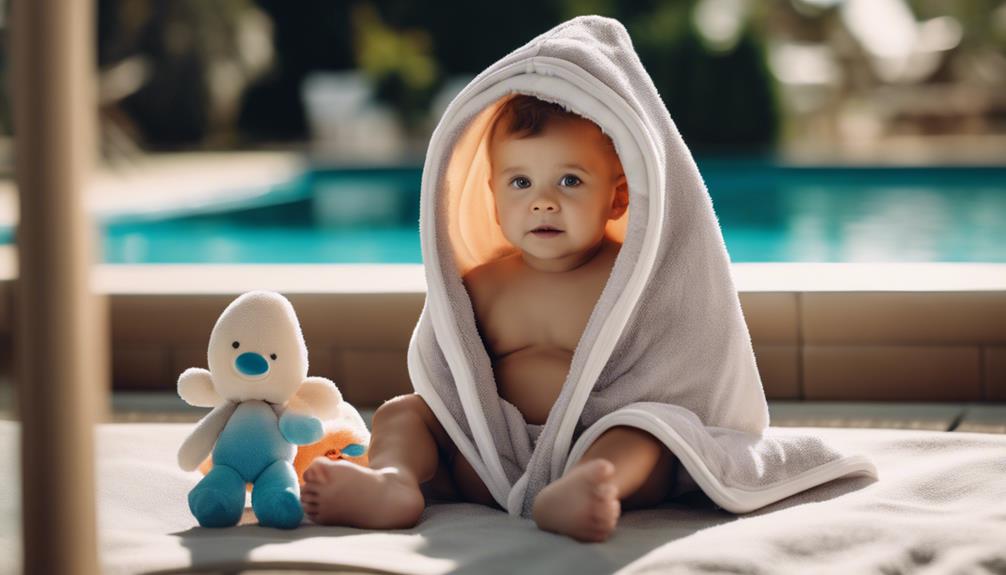
To enhance your toddler's comfort by providing additional warmth and insulation at the poolside, contemplate incorporating various items such as neoprene wet suits, thermal clothing, and hot water bottles. These items can help keep your little one cozy and protected, especially when dealing with cold water or when swimming starts affecting their body temperature.
Here are some essential poolside comfort items to contemplate:
- Neoprene Wet Suits or Wraps: Ideal for providing an extra layer of insulation and warmth, especially in colder water conditions.
- Thermal Clothing: Dress your toddler in long sleeve thermal tops and pants underneath their swimsuit to help retain heat.
- Hot Water Bottles: Bringing a warm hot water bottle in your toddler's swim bag can aid in maintaining their body temperature post-swim.
- Hooded Towels: Great for wrapping your toddler after swimming to prevent chills and lock in warmth.
Frequently Asked Questions
How to Keep a Toddler Warm in a Swimming Pool?
To keep a toddler warm in a swimming pool, dressing them appropriately is essential. Layering with a neoprene suit, thermal rashies, or wetsuits helps regulate body temperature.
Post-swim, make sure they're wrapped in a hooded towel or warm clothing to prevent chills. Hats, coats, and socks are vital when leaving the pool, especially in colder weather.
Proper clothing and accessories are key to maintaining warmth and comfort for your toddler during pool time.
How Cold Is Too Cold for a Toddler to Swim?
When considering how cold is too cold for a toddler to swim, it's important to prioritize their comfort and well-being. Toddlers are more sensitive to lower temperatures than adults, so maintaining the water temperature around 30 degrees Celsius is ideal.
Signs of water that's too cold include shivering, pale skin, and reluctance to engage in water activities. Make sure your toddler wears appropriate swimwear to retain body heat and monitor their comfort level regularly to prevent exposure to excessively chilly conditions.
How Do I Keep My 2 Year Old Safe in the Pool?
To keep your 2-year-old safe in the pool, constant supervision is vital. Make sure your child is within arm's reach at all times to prevent accidents.
Use proper flotation devices like life jackets or arm floaties. Teach basic water safety rules like no running near the pool and entering the water only with an adult present.
Enroll your toddler in swim lessons to build essential swimming skills and water confidence.
How Long Can a Toddler Be in a Pool?
You need to be mindful of your toddler's time in the pool. Ideally, limit sessions to around 30 minutes to prevent overexposure to cold water.
Extended stays may lead to discomfort, shivering, and health risks. Remember, individual sensitivity and water temperature play a role in determining safe durations.
Keep a close eye on your child for signs of discomfort or dropping body temperature. Opt for shorter, active swimming sessions for a more enjoyable pool experience.
What Are the Best Ways to Keep Toddlers Warm in the Pool?
When it comes to keeping child warm swimming pool, there are a few effective ways to ensure your toddler stays comfortable in the water. Invest in a good quality wetsuit or swim shirt to provide extra warmth. Additionally, using heated pools or swimming during the warmest part of the day can help keep your toddler cozy during pool time.
Conclusion
As you wrap up your day at the pool with your little one, remember that keeping them warm is crucial to their comfort and safety.
Just like a cozy blanket on a chilly night, proper thermal swimwear, warm-up routines, and post-swim essentials will guarantee your toddler stays snug and happy in the water.
So next time you hit the pool, make sure to prioritize warmth for a splashing good time!



